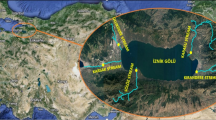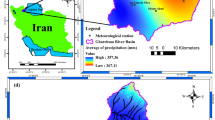Abstract
Runoff prediction plays an important guiding role in water resources planning and management, flood and drought prevention. As the Hanjiang River Basin (HRB) is the water source of the middle line of the South-to-North Water Diversion Project, it has higher requirements for water resources accurate prediction. In order to analyze the prediction capabilities of different prediction methods for the HRB runoff, this study constructed 12 prediction models to simulate and predict the runoff of four hydrological stations in the HRB. Furthermore, the Markov Chain Monte Carlo (MCMC) method was used to analyze the transition probability of runoff from low-to-high (high-to-low). The results showed that the runoff of four hydrological stations in the HRB all showed a downward trend, and most of the sudden changes occurred in the 1980 s. The smoother the runoff changes, the easier it is to make accurate prediction. Among the 12 models, the quadric spline Markov forecasting model (QS-MFM), moving average Markov forecasting model (MA-MFM), Markov forecasting model (MFM), deep neural networks (DNN), and cubic exponential smoothing (CES) methods have stronger generalization ability and can more accurately predict the runoff of the HRB. The average relative error during the validation period is 0.27, 0.28, 0.33, 0.34 and 0.39, respectively. The logistic model can accurately simulate the change of runoff status in the HRB. The wet threshold of Baihe (BH), Huanglongtan (HLT), Huangjiagang (HJG), and Huangzhuang (HZ) is 819.9 m3/s, 207.4 m3/s, 1313.9 m3/s and 1681.7 m3/s, and the dry threshold is 480.4 m3/s, 130.6. m3/s, 817.8 m3/s and 1083.4 m3/s, respectively. The MCMC method can accurately estimate the parameters of the logistic model, and the low-high (high-low) runoff transition probability model constructed in the HRB can accurately calculate the low to high (high to low) runoff transition probability.












Similar content being viewed by others
References
Archer DR, Fowler HJ (2008) Using meteorological data to forecast seasonal runoff on the River Jhelum. Pak J Hydrol 361:10–23. https://doi.org/10.1016/j.jhydrol.2008.07.017
Badrzadeh H, Sarukkalige R, Jayawardena AW (2015) Hourly runoff forecasting for flood risk management: application of various computational intelligence models. J Hydrol 529:1633–1643. https://doi.org/10.1016/j.jhydrol.2015.07.057
Carmona-Benítez RB, Nieto MR (2020) SARIMA damp trend grey forecasting model for airline industry. J Air Transp Manag 82:101736. https://doi.org/10.1016/j.jairtraman.2019.101736
Chen X, Huang J, Han Z, Gao H, Liu M, Li Z, Liu X, Li Q, Qi H, Huang Y (2020) The importance of short lag-time in the runoff forecasting model based on long short-term memory. J Hydrol 589:125359. https://doi.org/10.1016/j.jhydrol.2020.125359
Cheng B, Li H, Yue S, Huang K (2019) A conceptual decision-making for the ecological base flow of rivers considering the economic value of ecosystem services of rivers in water shortage area of Northwest China. J Hydrol 578:124126. https://doi.org/10.1016/j.jhydrol.2019.124126
Chua LHC, Wong TSW (2011) Runoff forecasting for an asphalt plane by Artificial Neural Networks and comparisons with kinematic wave and autoregressive moving average models. J Hydrol 397:191–201. https://doi.org/10.1016/j.jhydrol.2010.11.030
Corrêa DC, Jüngling T, Small M (2020) Quantifying the generalization capacity of Markov models for melody prediction. Phys A Stat Mech Appl 549:124351. https://doi.org/10.1016/j.physa.2020.124351
Deng C, Zhang G, Li Z, Li K (2020) Interprovincial food trade and water resources conservation in China. Sci Total Environ 737:139651. https://doi.org/10.1016/j.scitotenv.2020.139651
Dong Z, Yang D, Reindl T, Walsh WM (2013) Short-term solar irradiance forecasting using exponential smoothing state space model. Energy 55:1104–1113. https://doi.org/10.1016/j.energy.2013.04.027
Dong H, Feng Z, Yang Y, Li P, You Z (2021) Sustainability assessment of critical natural capital: a case study of water resources in Qinghai Province, China. J Clean Prod 286:125532. https://doi.org/10.1016/j.jclepro.2020.125532
Doycheva K, Horn G, Koch C, Schumann A, König M (2017) Assessment and weighting of meteorological ensemble forecast members based on supervised machine learning with application to runoff simulations and flood warning. Adv Eng Inform 33:427–439. https://doi.org/10.1016/j.aei.2016.11.001
Feng J, Li L, Yang N, Hong Y, Pang M, Yao X, Wang L (2011) Critical chain construction with multi-resource constraints based on portfolio technology in South-to-North Water Diversion Project. Water Sci Eng 4:225–236. https://doi.org/10.3882/j.issn.1674-2370.2011.02.010
Ferrucci A, Vocciante M (2021) Improved management of water resources in process industry by accounting for fluctuations of water content in feed streams and products. J Water Process Eng 39:101870. https://doi.org/10.1016/j.jwpe.2020.101870
Ghumman AR, Ghazaw YM, Sohail AR, Watanabe K (2011) Runoff forecasting by artificial neural network and conventional model. Alexandria Eng J 50:345–350. https://doi.org/10.1016/j.aej.2012.01.005
Guo C, Chen Y, Xia W, Qu X, Yuan H, Xie S, Lin L-S (2020) Eutrophication and heavy metal pollution patterns in the water suppling lakes of China’s south-to-north water diversion project. Sci Total Environ 711:134543. https://doi.org/10.1016/j.scitotenv.2019.134543
He X, Luo J, Zuo G, Xie J (2019) Daily runoff forecasting using a hybrid model based on variational mode decomposition and deep neural networks. Water Resour Manag 33:1571–1590. https://doi.org/10.1007/s11269-019-2183-x
He X, Luo J, Li P, Zuo G, Xie J (2020) A hybrid model based on variational mode decomposition and gradient boosting regression tree for monthly runoff forecasting. Water Resour Manag 34:865–884. https://doi.org/10.1007/s11269-020-02483-x
Khan MMH, Muhammad NS, El-Shafie A (2020) Wavelet based hybrid ANN-ARIMA models for meteorological drought forecasting. J Hydrol 590:125380. https://doi.org/10.1016/j.jhydrol.2020.125380
Li J, Liu Z, He C, Yue H, Gou S (2017) Water shortages raised a legitimate concern over the sustainable development of the drylands of northern China: evidence from the water stress index. Sci Total Environ 590–591:739–750. https://doi.org/10.1016/j.scitotenv.2017.03.037
Li B, Biswas A, Wang Y, Li Z (2021) Identifying the dominant effects of climate and land use change on soil water balance in deep loessial vadose zone. Agric Water Manag 245:106637. https://doi.org/10.1016/j.agwat.2020.106637
Liu Q (2014) An Improved SA-based BP-ANN technique for annual runoff forecasting under uncertain environment BT. In: Xu J, Fry JA, Lev B, Hajiyev A (eds) Proceedings of the seventh international conference on management science and engineering management. Springer Berlin Heidelberg, Berlin, pp 1467–1474
Löwe R, Mikkelsen PS, Madsen H (2014) Stochastic rainfall-runoff forecasting: parameter estimation, multi-step prediction, and evaluation of overflow risk. Stoch Environ Res Risk Assess 28:505–516. https://doi.org/10.1007/s00477-013-0768-0
Ma XX, Zhu HQ, Xiao Y, Wang WS, Wang HL, Zhang JW (2020) Inspection method for random simulation of runoff sequence based on sample entropy and statistical parameters. J Hydrol 581:124392. https://doi.org/10.1016/j.jhydrol.2019.124392
Meyers SD, Landry S, Beck MW, Luther ME (2021) Using logistic regression to model the risk of sewer overflows triggered by compound flooding with application to sea level rise. Urban Clim 35:100752. https://doi.org/10.1016/j.uclim.2020.100752
Moosavi V, Talebi A, Hadian MR (2017) Development of a hybrid wavelet packet-group method of data handling (wpgmdh) model for runoff forecasting. Water Resour Manag 31:43–59. https://doi.org/10.1007/s11269-016-1507-3
Nygren M, Giese M, Kløve B, Haaf E, Rossi PM, Barthel R (2020) Changes in seasonality of groundwater level fluctuations in a temperate-cold climate transition zone. J Hydrol X 8:100062. https://doi.org/10.1016/j.hydroa.2020.100062
Ouyang R, Cheng W, Wang W, Jiang Y, Zhang Y, Wang Y (2007) Research on runoff forecast approaches to the Aksu River basin. Sci China Ser D Earth Sci 50:16–25. https://doi.org/10.1007/s11430-007-5008-3
Pan T, Wang R (2004) State space neural networks for short term rainfall-runoff forecasting. J Hydrol 297:34–50. https://doi.org/10.1016/j.jhydrol.2004.04.010
Parida BP, Moalafhi DB, Kenabatho PK (2006) Forecasting runoff coefficients using ANN for water resources management: the case of Notwane catchment in Eastern Botswana. Phys Chem Earth Parts A/B/C 31:928–934. https://doi.org/10.1016/j.pce.2006.08.017
Piotrowski AP, Napiorkowski JJ (2012) Product-Units neural networks for catchment runoff forecasting. Adv Water Resour 49:97–113. https://doi.org/10.1016/j.advwatres.2012.05.016
Qi B, Liu H, Zhao S, Liu B (2020) Observed precipitation pattern changes and potential runoff generation capacity from 1961–2016 in the upper reaches of the Hanjiang River Basin, China. Atmos Res. https://doi.org/10.1016/j.atmosres.2020.105392
Qu X, Chen Y, Liu H, Xia W, Lu Y, Gang D-D, Lin L-S (2020) A holistic assessment of water quality condition and spatiotemporal patterns in impounded lakes along the eastern route of China’s South-to-North water diversion project. Water Res 185:116285. https://doi.org/10.1016/j.watres.2020.116275
Sedki A, Ouazar D, El Mazoudi E (2009) Evolving neural network using real coded genetic algorithm for daily rainfall–runoff forecasting. Expert Syst Appl 36:4523–4527. https://doi.org/10.1016/j.eswa.2008.05.024
Shappell NW, Shipitalo MJ, Billey LO (2021) Estrogenicity of agricultural runoff: a rainfall simulation study of worst-case scenarios using fresh layer and roaster litter, and farrowing swine manure. Sci Total Environ 750:141188. https://doi.org/10.1016/j.scitotenv.2020.141188
Smyl S (2020) A hybrid method of exponential smoothing and recurrent neural networks for time series forecasting. Int J Forecast 36:75–85. https://doi.org/10.1016/j.ijforecast.2019.03.017
Stanislavsky A, Nitka W, Małek M, Burnecki K, Janczura J (2020) Prediction performance of Hidden Markov modelling for solar flares. J Atmos Solar-Terrestrial Phys 208:105407. https://doi.org/10.1016/j.jastp.2020.105407
Tian W, Liu X, Liu C, Bai P (2018) Investigation and simulations of changes in the relationship of precipitation-runoff in drought years. J Hydrol 565:95–105. https://doi.org/10.1016/j.jhydrol.2018.08.015
Turunen M, Gurarslan G, Šimůnek J, Koivusalo H (2020) What is the worth of drain discharge and surface runoff data in hydrological simulations? J Hydrol 587:125030. https://doi.org/10.1016/j.jhydrol.2020.125030
Wang W, Chau K, Qiu L, Chen Y (2015) Improving forecasting accuracy of medium and long-term runoff using artificial neural network based on EEMD decomposition. Environ Res 139:46–54. https://doi.org/10.1016/j.envres.2015.02.002
Wu J (2018). In: Huang D-S, Bevilacqua V, Premaratne P, Gupta P (eds) Co-evolution algorithm for parameter optimization of RBF neural networks for rainfall-runoff forecasting BT-intelligent computing theories and application. Springer, Cham, pp 195–206
Xiang X, Fu H, Zhou J, Deng Y, Yang X (2021) Taboo rate and hitting time distribution of continuous-time reversible Markov chains. Stat Probab Lett 169:108969. https://doi.org/10.1016/j.spl.2020.108969
Xie T, Zhang G, Hou J, Xie J, Lv M, Liu F (2019) Hybrid forecasting model for non-stationary daily runoff series: a case study in the Han River Basin, China. J Hydrol 577:123915. https://doi.org/10.1016/j.jhydrol.2019.123915
Xiu-fen Z, Li-shan K, Hong-qing C, Zhi-jian W (2003) A hybrid model for the mid-long term runoff forecasting by evolutionary computation techniques. Wuhan Univ J Nat Sci 8:234–238. https://doi.org/10.1007/BF02899485
Yaduvanshi A, Nkemelang T, Bendapudi R, New M (2021) Temperature and rainfall extremes change under current and future global warming levels across Indian climate zones. Weather Clim Extrem 31:100291. https://doi.org/10.1016/j.wace.2020.100291
Yang Q, Yu Z, Wei J, Yang C, Gu H, Xiao M, Shang S, Dong N, Gao L, Arnault J, Laux P, Kunstmann H (2021) Performance of the WRF model in simulating intense precipitation events over the Hanjiang River Basin, China – a multi-physics ensemble approach. Atmos Res 248:105206. https://doi.org/10.1016/j.atmosres.2020.105206
Yu Z, Wang H, Miao M, Kong Q, Quan Q, Wang R, Liu J (2020) Long-term monitoring of community succession in impoundment lake: responses of macroinvertebrate to South-to-North Water Diversion Project. Ecol Indic 118:106734. https://doi.org/10.1016/j.ecolind.2020.106734
Yu X, Sreekanth J, Cui T, Pickett T, Xin P (2021) Adaptative DNN emulator-enabled multi-objective optimization to manage aquifer – sea flux interactions in a regional coastal aquifer. Agric Water Manag 245:106571. https://doi.org/10.1016/j.agwat.2020.106571
Zhang Z, Hu B, Jiang W, Qiu H (2021) Identification and scenario prediction of degree of wetland damage in Guangxi based on the CA-Markov model. Ecol Indic 127:107764. https://doi.org/10.1016/j.ecolind.2021.107764
Zhou Y, Guo S, Hong X, Chang F-J (2017) Systematic impact assessment on inter-basin water transfer projects of the Hanjiang River Basin in China. J Hydrol 553:584–595. https://doi.org/10.1016/j.jhydrol.2017.08.039
Zhu J, Zhang Z, Lei X, Jing X, Wang H, Yan P (2021) Ecological scheduling of the middle route of south-to-north water diversion project based on a reinforcement learning model. J Hydrol 596:126107. https://doi.org/10.1016/j.jhydrol.2021.126107
Acknowledgements
The research is financially supported by National Natural Science Foundation of China (Grant Nos. U1911204, 51861125203), National Key R&D Program of China (2017YFC0405900), The Project for Creative Research from Guangdong Water Resources Department (Grant Nos. 2018, 2020).
Author information
Authors and Affiliations
Corresponding author
Ethics declarations
Conflict of interest
The authors declare no conflict of interest.
Additional information
Publisher’s Note
Springer Nature remains neutral with regard to jurisdictional claims in published maps and institutional affiliations.
Rights and permissions
About this article
Cite this article
Jin, H., Chen, X. & Zhong, R. Runoff forecast and analysis of the probability of dry and wet transition in the Hanjiang River Basin. Stoch Environ Res Risk Assess 36, 1485–1502 (2022). https://doi.org/10.1007/s00477-021-02096-9
Received:
Accepted:
Published:
Issue Date:
DOI: https://doi.org/10.1007/s00477-021-02096-9




